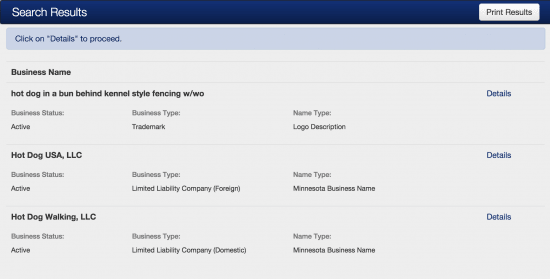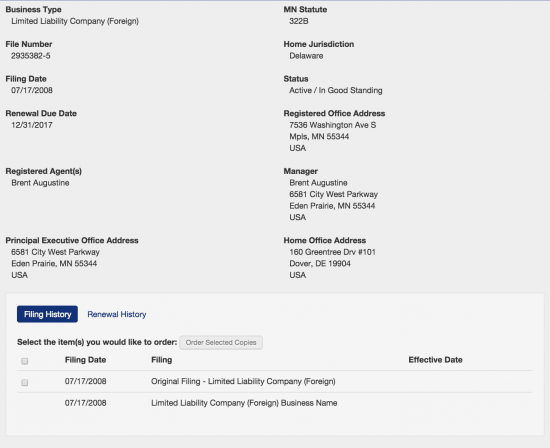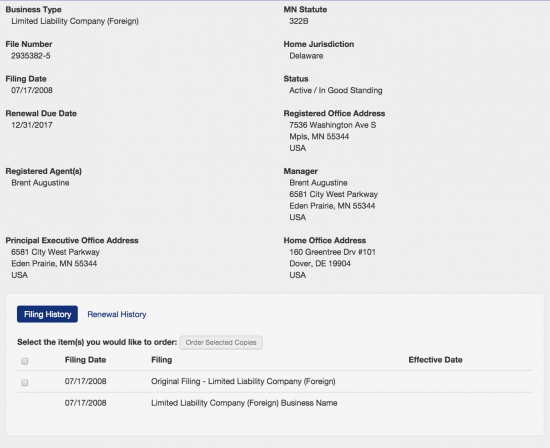How to Conduct a Minnesota Business Entity Search
Learn how to run a Minnesota business search to learn more about registered businesses on file with the Secretary of State.

Last Updated: July 10, 2025
The Minnesota business record search, sometimes called a Minnesota business search or business entity search, is a valuable tool for anyone who needs to learn more about a company. Whether you’re a veteran business owner who needs to request a Certificate of Good Standing or a soon-to-be entrepreneur who needs to research business name availability, the business record search is a go-to resource.
But using this tool can feel overwhelming, especially if you’ve never used a database search like this before. That’s where this guide comes in. We’ll walk you through the essential steps to using the search. We’ll also talk about Minnesota business naming rules and what you should do after searching a business name.
Let’s get started.
Minnesota Secretary of State Contact Information
| Address: 332 Minnesota Street, Suite N201 St. Paul, MN 55101 | Email: business.services@state.mn.us |
| Telephone: (651) 201 – 1324 | Website: https://www.sos.state.mn.us/ |
Minnesota Business Name Guidelines
When you’re starting a business, one of the most important things you’ll do is pick your business name. And like other states, Minnesota has several rules about naming your business.
First, your name needs to be different from the names of other registered companies in Minnesota, including both domestic and foreign corporations, limited liability companies (LLCs), limited partnerships, and so on. This is one of the simplest but most important naming standards.
That said, uniqueness isn’t the only naming guideline to adhere to. Here are a few other rules your Minnesota business name should follow:
- Minnesota doesn’t require a corporation’s business name to include a designator. However, if you wish, you can include words or abbreviations like “corporation,” “limited,” “incorporated,” or similar terms or their abbreviations. That said, if you use a designator, it must match your business type.
- Meanwhile, LLC names must include the phrase “Limited Liability Company” or its abbreviation, “LLC.”
- Your name must be in English, or, if it’s in another language, it must be written using standard English letters or characters.
- Your name can’t state or imply that you’re conducting activities that aren’t permitted by law.
If you’re in a licensed trade or profession, keep in mind that you’ll need to meet any naming rules that your industry has in place, too. If your business name doesn’t meet these requirements, you’ll need to pick a new one.
How to Search by Business Name
Minnesota allows you to search its business database in one of two ways: by business name or by filing number. Here, we’ll cover how to search by business name (keep scrolling if you want to learn how to search by file number).
Step 1: Set your search filters and type your search
To get started, navigate to the search homepage. By default, the search is set to the “Business Name” category, but before you start typing, check that it’s set correctly.
Next, you can set a few filters for your search. Here are your options:
- Search Scope: You can set the search to “contains” or “begins with” to filter the results you get. “Begins with,” the default setting, will show you all of the business names that start with the words you search. Meanwhile, the “Contains” setting acts more like a keyword search, displaying the business names that include your search terms anywhere in the name.
- Filing Status: This lets you filter your results by active entities only or inactive ones.
- Include Prior Names: This filter lets you include or exclude previous business names in your search results. If you want to see names that a business used to use, set it to “Include.”
By default, the search is set to “Begins With,” “Active,” and “Exclude,” but you can change them to meet your search goals.
After you’ve set your search filters, it’s time to type your search terms into the search bar; leave any company designators off of your search. Then, hit “Search.”

Step 2: Review your search results
The search tool will pull up all of the businesses that match your search terms. For example, here’s what our results page looked like when we ran a search of “hot dog:”

For each listing, you’ll see the full name of the company (or, in the case of this example, the full description of the trademark), the business type, and the type of name it is (including assumed names, trademarks, business names, or logo descriptions).
On the far right side, you’ll see a link labeled “Details.” Clicking on it will show you even more information about the company.

Here, you’ll see the company’s file number, filing date, renewal due date, registered agent name and address, and physical address for the business. You’ll also see information about principal individuals for the company, such as members or managers for an LLC or directors or officers for a corporation.
This business details page also allows you to review the business filing history, request a Certificate of Good Standing, file a renewal or amendment, or get certified copies.
How to Check Business Name Availability
If you’re looking to start a Minnesota corporation or LLC, it’s your responsibility to make sure that your name doesn’t infringe on the names of existing businesses. That’s where a name availability search comes in.
Technically, the Minnesota Secretary of State’s website doesn’t have a specific tool that’s dedicated to checking name availability, but you can still use the name search feature to research names. To do so, simply set the tool’s settings to “Contains” and type the full business name you’re hoping to use (minus a company designator). Then click “Search.”
Ideally, you’ll see a message that reads, “No results match the criteria entered.” This message means there aren’t any names on file that match the name you searched, so the name is probably available. You can probably use it for your Minnesota LLC or corporation.
But if any matches do appear, then your desired LLC name isn’t available. You’ll need to make some changes or pick a different name so your company name is unique.
How to Search by File Number
The Minnesota Secretary of State’s office assigns a unique file number to every business that registers in the state. The good news? You can use a filing number to look up a business directly — no need to sift through dozens (or even hundreds) of other business names.
To get started, navigate to the search homepage and then switch from “Business Name” to “File Number” (pictured below). Then, carefully type in the company’s file number and click “Search.”

As long as you typed the number correctly, you’ll be taken directly to the Minnesota entity’s business details page. There, you can review all of the information about your company that’s available for public access, including the entity type, principal individuals, activity status, and more. You can also review your business filings, request standing certificates, order copies of business documents, and make renewals here, too.

What to Do After Searching Business Names in Minnesota
After you’ve come up with a name and checked it against the Minnesota business search, you’re probably feeling like you’ve done a lot of legwork. You’d hate for that hard work to go to waste, right? Here are some steps you can take to protect your Minnesota business name and make the most of it.
Reserve your Minnesota company name (optional)
If you’ve picked the perfect business name but you’re not quite ready to file your business formation paperwork, Minnesota allows you to reserve a business name.
You can reserve a Minnesota company name by filing a Name Reservation/Request for Reservation of Name form with the Secretary of State. Your filing fee will vary depending on how you file. Mailed filings cost $35, while online filings or expedited ones cost $55.
After your paperwork is filed and approved, your name reservation will be valid for one year; you’re allowed to renew your reservation if needed. This step is optional, and you should only pursue it if you’ve picked a name but aren’t ready to file your formation paperwork and conduct business yet.
Form an LLC or register your business
One of the best ways to protect your business name is to register your business. After you register a business under your chosen name, no one else in Minnesota will be able to register their own company with the same name.
Registering a business with the Minnesota Secretary of State is an important legal process. Learn more about starting a Minnesota LLC.
Get a domain name that matches
You want your customers to find your business website easily. That means you need a domain name that matches your business name as closely as possible. A matching domain will help your brand maintain consistency both in person and online.
If you’re struggling to come up with a domain name (or the one that matches your name is already taken), try using a domain name generator. A generator can help you come up with a domain that matches your brand image.
Set up your business online
Today, you can’t run a business without a good digital footprint. A good business website is a decent starting point. But don’t stop there; set up social media accounts like a Facebook page, a TikTok profile, and an Instagram account. Make sure your business name is included on each account so your brand is consistent across your online presence.
Last but not least, set up a Google Business Profile for your business (or claim it if it already exists). This profile will help you direct customers to your website or your store location. Plus, it’ll help you respond to customer reviews and build a good brand reputation in the Land of 10,000 Lakes.
Trademark your business name (optional)
If you want the most robust protections for your business name, you could pursue trademark registration. Trademarks can be registered at the state or federal level (with federal protections being the strongest).
Getting a trademark can be pretty complicated and time-consuming. If you go this route, it’s highly recommended to work with a trademark attorney.
Start an LLC in Your State
When it comes to compliance, costs, and other factors, these are popular states for forming an LLC.
Conduct an Entity Search in Your State
Disclaimer: The content on this page is for information purposes only and does not constitute legal, tax, or accounting advice. If you have specific questions about any of these topics, seek the counsel of a licensed professional.
Let's Get Started

